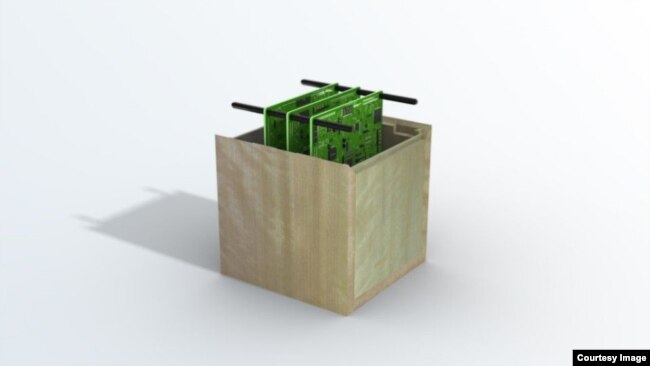想像してみてください。
宇宙を周回する”木のサテライト”を!!!
木の可能性、無限大?!
紙と木で出来てた江戸景色、、、なぜか彷彿とさせるわ~!
下記を頭に入れて、
cedar :【síːdər】杉
birch :【 bɝːtʃ】樺
今日のVOAニュース
これからの日本の技術です。
日本、世界初の木造衛星打ち上げを目指して
Japan Aims to Launch World’s First Wooden Satellite
January 10, 2021

住友林業と京都大学の研究者が開発中の木製衛星模型のイラストです。住友林業
日本の研究者たちは、世界初の木で作られた人工衛星の建設に取り組んでいると言っています。
その目的は、宇宙廃品の問題との戦いを支援することです。Space junk 宇宙廃品とは、死んだ人工衛星、失われた機器の破片、小さな塗料の破片などです。このようなものは、宇宙空間で活動する宇宙船や人工衛星に脅威を与える可能性があります。
このプロジェクトは、住友林業と京都大学の共同プロジェクトです。開発チームは最近、ニュースリリースで人工衛星の計画を発表しました。
研究者によると、 LignoSat リグノサットと呼ばれるこの木製人工衛星は、将来的に宇宙で木材がどのように使われるかを探るいくつかのプロジェクトのうちの1つであるといいます。
開発者によると、人工衛星の建設に一般的に使用されているアルミニウムや他の金属などの材料よりも、木材の方がいくつかの利点があるとのことです。
例えば、木材は電磁波を遮断しないということです。このため、木造構造物は、アンテナ機器やその他の制御装置を格納するために使用することができると、研究チームは声明で述べています。
また、木造構造物は設計が簡単で、現在の衛星機器よりも重量が軽いと研究者は付け加えています。そのような衛星は、地球の大気圏に再突入するときに燃え尽きるので、環境にも良いでしょう。また、大気や海に汚染粒子を放出することもありません。
宇宙廃品:拡大する問題
研究者たちは、スペースジャンクが問題になっていると言います。現在、何千もの非稼働衛星が地球を周回しており、新しい衛星の数は増え続けています。昨年、欧州と国連の機関は、スペースジャンクに対処するための世界的な行動計画を策定していることを発表しました。機関は、新しい人工衛星のスペースを確保するために、地球を周回する廃棄物を一掃しなければならないとしています。
この計画のリーダーの一人は、京都大学の教授でもある日本人宇宙飛行士の土井隆夫氏です。同氏はBBCニュースの取材に対し、このプロジェクトの原動力は、人工衛星から放出される汚染物質を制限する必要があることだと語っています。
「最終的には地球の環境に影響を与えます 。」と土井氏は話します。研究プロセスの最初のステップが完了した後、チームは "衛星のエンジニアリングモデルの開発 "に着手するとしています。その後、衛星の飛行モデルを製作します。
最初の木製衛星は2023年までに打ち上げられる可能性があります。
研究者たちは、このプロジェクトにはいくつかの大きな技術的な問題があることを認めています。それは、厳しい温度環境下でも形を保ち、長期間にわたって強い日差しに耐えられる木質材料を見つけることです。
日本のプロジェクトでは、宇宙の過酷な環境に耐えられるさまざまな木質材料と保護コーティングの研究が行われています。研究チームは、杉や樺の木を使った木造建築の研究を行っています。
また、他の木製品が宇宙空間でどのように機能するかを研究する予定です。宇宙ステーションのような過酷な環境下でも、木が人間の役に立つかどうかを調べたいと考えています。
このプロジェクトをバックアップする住友林業は、木材を主原料とした建物も開発しています。2018年には、同社最大のプロジェクトとして、東京都内に350メートルの木造超高層ビルを建設することを発表しました。2041年までに完成させることを目標にしているといいます。
Japan Aims to Launch World’s First Wooden Satellite
 Shown is an illustration of a wooden satellite model being developed by researchers from Sumitomo Forestry company and Japan’s Kyoto University. (Sumitomo Forestry)
Shown is an illustration of a wooden satellite model being developed by researchers from Sumitomo Forestry company and Japan’s Kyoto University. (Sumitomo Forestry)
Japanese researchers say they are working to build the world’s first satellite made of wood.
The goal is to help fight the problem of space junk. Space junk includes things like dead satellites, lost pieces of equipment and small pieces of paint. Such objects can present threats to spacecraft and satellites operating in space.
The project is a joint effort involving the company Sumitomo Forestry and Japan’s Kyoto University. The development team recently announced plans for the satellite in a news release.
The researchers say the wooden satellite – which they call LignoSat – is one of several planned projects that seek to explore how wood might be used in space in the future.
The developers say wood offers several advantages over other materials commonly used to build satellites, such as aluminum and other metals.
For example, the researchers say wood does not block electromagnetic waves. For this reason, wooden structures could be used to house antenna equipment and other controlling devices, the team said in a statement.
Wooden structures would also be simpler to design and weigh less than current satellite equipment, the researchers added. Such satellites would be better for the environment because they would burn up when reentering Earth’s atmosphere. They would not release polluting particles into the air and oceans.
Space junk: a growing problem
The researchers say space junk is a growing problem. Thousands of non-operating satellites are currently orbiting the Earth, and the number of new satellites continues to grow. Last year, European and United Nations agencies announced they were developing a plan for worldwide action to deal with space junk. The agencies said waste orbiting the earth must be cleaned up to make room for new satellites.
One of the leaders of the project is Japanese astronaut Takao Doi, who is also a professor at Kyoto University. He told BBC News that the driving force behind the project is the need to limit pollutants released from satellites that remain in the upper atmosphere for many years.
"Eventually it will affect the environment of the Earth," Doi said. He added that after the first steps in the research process are completed, the team will begin “developing the engineering model of the satellite.” After that, a satellite flight model will be manufactured.
The first wooden satellite could be launched by 2023.
The researchers admit that the project presents some big technological problems. These include finding a wood material that can keep its shape in severe temperatures and survive intense sunlight over a long period of time.
The Japanese project involves researching different wood-based materials and protective coatings that can hold up in the extreme conditions of space. The team is studying the construction of wooden structures using cedar and birch wood.
The researchers also plan to study how other wood products would perform in space. They want to find out whether trees could help humans in extreme environments such as space stations.
The company backing the project, Sumitomo Forestry, has also developed buildings made mainly of wood. In 2018, the company announced its largest project, a 350-meter wooden skyscraper to be built in Tokyo. It says the goal is to complete the building by 2041.
_______________________________________________________________
Words in This Story
junk – n. material that is no longer of use or working
advantage – n. something that is good or desirable
antenna – n. a device used to send or receive communications signals
coating – n. a thin layer of a substance that covers an object for the purpose of protecting it or for some other reason